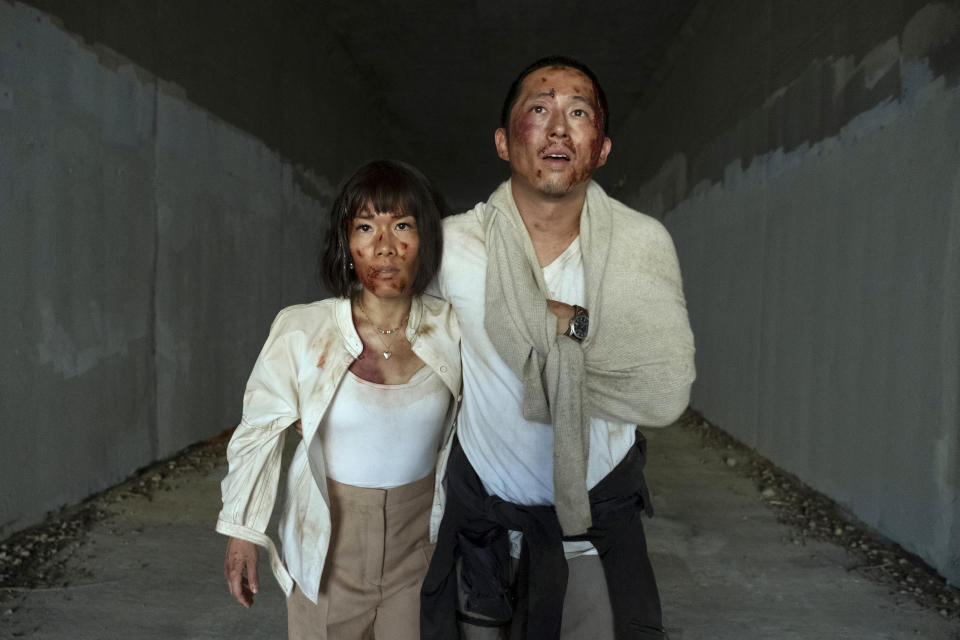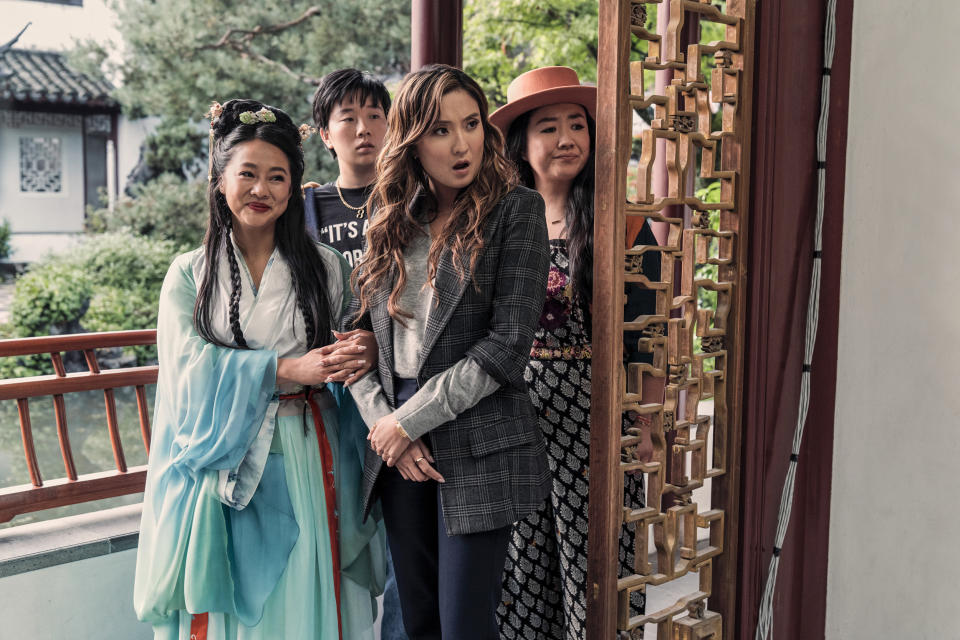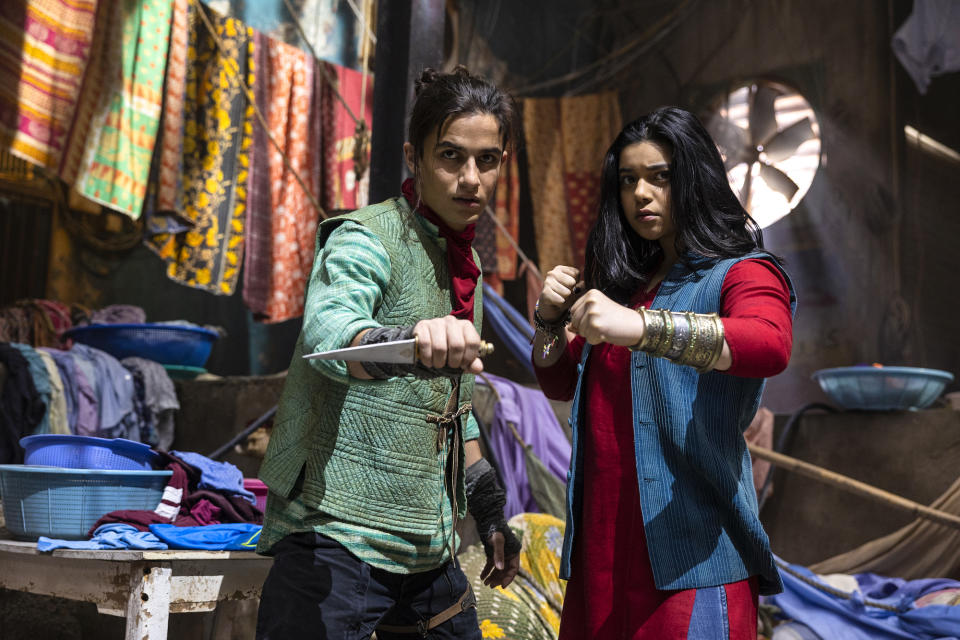Asian Americans are no longer pop culture sidekicks — they're defining the mainstream
Netflix’s “Beef” dives deep into the psyches of two people who happen to be Asian American as they’re entangled in a universal experience — road rage. But what the show doesn’t do is spend time with heavy-handed explanations about the cultural nuances of identity.
And it’s because Asian American and Pacific Islander creators have reached a point where they don’t necessarily feel they have to, critics say. Starring an all-Asian cast, “Beef” is an example of how Asian Americans are seeing pieces of themselves and their families comfortably integrated into on-screen stories like never before.
A proliferation of movies and television shows in recent years has made it clear Asian Americans are no longer chasing the opportunity to merely be included. Instead, diaspora storytellers are increasingly defining mainstream culture while creating their own spaces on their own terms — without feeling the need to contextualize their stories for the masses.
While “Beef” revolves around the accessible feelings of anger, grief and resentment, the storyline still includes pieces of the Asian American experience, like Danny’s (Steven Yeun) emotional experience during a service at a Korean evangelical church.

“But the way it was handled was an example of how ‘Beef’ didn’t feel the need to contextualize or over-explain itself for viewers outside the Asian American community,” said Seo-Young Chu, an associate professor of English at Queens College in Queens, New York.
She said “Beef” provides a deeply complex story about traumatic events that can lead people to spiral — a story not often told in this way for Asian American communities.
“I appreciated its textured, layered, lively portrayal of complex Asian American characters whose inner lives rhymed with my own,” she said in an email. “As an Asian American person who struggles with anger, stress, resentment, indebtedness, generational trauma, suicidal ideation and the pressure to smile graciously even while tolerating mistreatment, I found ‘Beef’ powerfully resonant. It seemed to represent parts of me that had never been represented before.”
‘Beef’ didn’t feel the need to contextualize or over-explain itself for viewers outside the Asian American community,” said Seo-Young Chu, an associate professor of English at Queens College in Queens, New York.
There are, of course, limitations to representation, and she points to the fact that her excitement about the show changed after clips revealing “Beef” actor David Choe’s self-proclaimed “rapey behavior” resurfaced.
“With art, the stakes are always high. When I learned that David Choe had bragged about being a ‘successful rapist,’ I felt violently betrayed,” Chu said. “I feel more solidarity with survivors who were harmed by his words than with the show’s fans and supporters.”
Although Choe’s past comments overshadowed the show’s acclaim, Chu, like other Asian Americans, said the actual storyline and characters still resonated.
AAPI creators aren’t explaining themselves to mainstream audiences but attract them anyway
From “Everything Everywhere All at Once” to “Ms. Marvel” to this year’s “Joy Ride,” recent Asian American films have increasingly tackled the diaspora experience. Films made for mainstream audiences are no longer shying away from putting the cultural nuances of diaspora characters on full display.
For Kevin Lihuan Lee, a film production master’s student at Columbia University, growing up watching movies that gave nuance to white characters while relegating people of color to stereotypical or one-dimensional roles taught him to view white experiences as a universal default.

Then, “Crazy Rich Asians” released in 2018 with an all-Asian cast. Soon afterward came “The Farewell,” then “Shang-Chi,” then “Turning Red.” That’s when Lee began catching all the subtle details in the films that, for the first time, made him catch glimpses of himself and his own family.
“Turning Red,” for example, captures such a common mother-daughter conflict — of a child’s feeling caged in after she develops interests that don’t align with what her parent believes is best, Lee said. The way Mei tries so hard to keep the peace with Ming, even if it means bottling up her emotions, is instantly relatable to Lee. It reminds him of the way many Asian Americans tend to internalize their feelings for the sake of keeping family happy.
“And then ‘Everything Everywhere’ came out, and it just socked me in the face,” he said. “Even the subtleties of the characters’ speaking Mandarin one second and then Cantonese another second and then English another second and they hop back and forth in between their words. That’s how I speak at home with my parents.”
How to create authentic characters? Just ask, ‘What’s funny and embarrassing to us?’
Canadian filmmaker Domee Shi, who directed “Turning Red” and the Disney Pixar short “Bao,” drew much of her storytelling inspiration from her own childhood and background. But to truly get Mei’s world right required enlisting a team capable of both researching and informing the film with their own lived experiences.
Shi said she often swapped stories with “Turning Red” co-writer Julia Cho, whose Korean American upbringing shared many similarities with her Chinese Canadian one.
“We just talked about our own experiences and what embarrassed us and what did we wish we did back then. And if we were to speak to our moms as tweens, what would we say and what would we want to hear from them?” Shi said. “It was important for me to make sure that we had a lot of people in the room that could speak to the main character’s background.”
Throughout the 1990s and the early 2000s, Shi said, Hollywood’s approach to race was often to adopt a colorblind attitude, so stories about people of color were usually not culturally specific. Now, however, she’s seeing more of an interest in exploring characters’ diverse backgrounds and incorporating rather than neglecting what makes them unique.
“You’re seeing studios’ finally opening their minds to what universal stories could look like and who gets to tell them,” Shi said. “But I think it’s an ongoing process, and we’re going to have to continue to support these types of stories, because it could so easily slip backwards at any moment.”
Progress for South Asian Americans
The debut of “Ms. Marvel,” featuring Marvel’s first Pakistani superhero, was a monumental victory for the South Asian diaspora, critics have said. For the first time, Marvel, a multibillion-dollar movie franchise, invested in a story that showcased the South Asian American female experience.
The show follows Kamala Khan, who is obsessed with the Avengers and is imbued with superpowers that come from a bangle passed down from her great-grandmother.
Harleen Singh, an associate professor of South Asian literature and women’s studies at Brandeis University, said she was impressed that the show used phrases in Urdu or a blend of Urdu and English in conversations, a common experience for the South Asian diaspora. In the first episode, Kamala’s mom tells her, “Come on, Kamala. Chalo,” which means, “Let’s go.”

“I think it adds accuracy to how people of color and how immigrants lead multiple lives and use multiple linguistic registers,” she said. “It’s fun and interesting but also adds a richer repository of words and phrases and representations you can draw from.”
She also said she appreciated the show’s decision not to over-explain the cultural and historical events in the series to viewers. In the series, the 1947 Partition, where millions of South Asian families were forced to cross over the newly formed India-Pakistan border, was integral to explaining how Kamala’s great-grandmother was endowed with her own powers during childhood as her family migrated to Pakistan.
“To actually put the Partition in there as a backstory was a real move of excellence. … There wasn’t this pedantic framing of what happened or what the British did,” she said. “It was almost like a call saying: ‘You should know about this, folks, and if you don’t, here’s a little tidbit. Now, go find out more.’”
Global success imported to the U.S.
Outside of the recent boom in diaspora media, recent years have also been marked by spectacular success from films and TV shows set in Asia, from “Parasite” to “RRR” to “Alice in Borderland.” Netflix last month committed $2.5 billion to South Korean film and TV production over the next four years — after shows such as “Squid Game” and “The Glory” shot to the top of the streaming service’s chart rankings.
Hannah Michell, a lecturer in Asian American film at the University of California, Berkeley, said that although many Asian Americans appreciated the way those films and T.V. series granted renewed visibility to Asian faces, such media doesn’t speak to diaspora experiences. Still, she said, such international works nonetheless helped catalyze more positive reception of Asian American works on a large scale.
“Unfortunately in Hollywood, it is a numbers game. To have a film like ‘Parasite’ win so many awards just shows that there is a market and proves that Asians can sell in terms of media,” Michell said. “So, from an industry perspective, it doesn’t feel as high-risk as it did before.”
Going beyond the typical exotification of Pacific Islanders, but room for more progress
While Asian diaspora communities are witnessing massive progress in seeing their own stories told accurately on the big screen, Hollywood has made much slower strides when it comes to capturing Pacific Islander perspectives in mainstream film and television.
After the news last month on who the cast and crew will be for the live-action “Lilo & Stitch,” fans had mixed feelings about the casting for Native Hawaiian roles. Some weren’t happy that a biracial, light-skinned actor will play Nani, Lilo’s older sister, who in the original movie was drawn with darker skin, black hair and ethnic features. “Nani is Indigenous Hawaiian with strong features and dark skin, this casting is blatant colorism,” one person tweeted.
For many Pacific Islanders, Disney’s release of “Moana” in 2016 remains monumental, according to Samoan visual anthropologist Dionne Fonoti.
“Locally in Samoa, the excitement around seeing that film, I think, was very much about the thrill of seeing elements of your culture represented in a very familiar way,” Fonoti said.
Some viewers have criticized the movie’s attempt to depict Polynesia as a whole without giving Moana a specific ethnicity or culture.
Fonoti said a lot of the initial skepticism around “Moana” comes from the recognition that Pacific Islanders have been featured in films since film was invented, but only so Western filmmakers and audiences can exoticize them.
But Fonoti said that since “Moana,” she’s seeing a gradual shift in Pacific Islanders’ taking on more positions of power in storytelling through cinema.
“You see the deliberateness of it now, which I don’t think we were seeing in the past, so I definitely think it’s evolved,” Fonoti said.
This article was originally published on NBCNews.com

